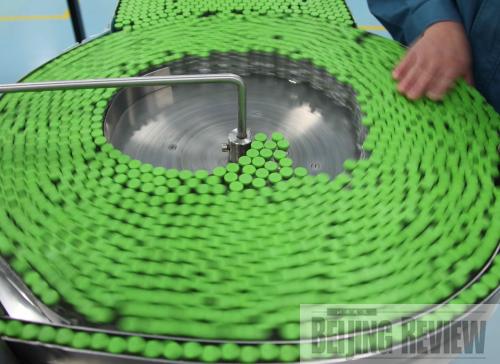|
 |
|
LIFE SAVERS: A/H1N1 flu vaccines are seen on a Beijing production line at Sinovac Biotech Ltd., a Chinese pharmaceutical company, on September 3 (XING GUANGLI) |
China vows to strengthen the prevention and control of the A/H1N1 flu virus in the run-up to the National Day celebrations, amid fears that the situation will worsen through autumn.
According to the State Council executive meeting presided over by Premier Wen Jiabao on September 7, schools are currently the key places in the country's fight against the virus and classes should be suspended "properly" to avoid mass infection when an outbreak occurs.
The mass outbreaks mainly among students have led to the closure of more than 20 schools stretching from south China's Guangxi Zhuang Autonomous Region to northwest China's Xinjiang Uygur Autonomous Region, just one week after the start of the new school term, a clear signal that the peak season has begun for the potentially deadly virus, said Zeng Guang, a senior epidemiologist at the Chinese Center for Disease Control and Prevention.
As the total cases reached 5,592 on the Chinese mainland on September 7, the virus has been detected in all 31 provinces, municipalities and autonomous regions.
Mass outbreaks
Since late June, there has been a spike in the number of mass outbreaks of A/H1N1 flu. By September 7, 128 mass outbreaks have been reported.
On September 4, the Langfang Health Bureau reported five confirmed A/H1N1 flu cases in Hebei Province's university town. Two days later, 67 people were confirmed to have contracted the virus at four universities, Hebei's health authorities announced.
In northwest China's Shaanxi Province, the number of cases at the Xi'an University of Arts and Science had risen to 44 as of September 7. Among them, 29 had recovered, while the others were in stable condition, said the Shaanxi Provincial Health Department.
Primary and middle schools in Urumqi, capital city of Xinjiang Uygur Autonomous Region, remained closed in the wake of a recent outbreak of 43 A/H1N1 flu cases. A total of 42 expert teams were sent to schools across the city to help prevent and cure the A/H1N1 flu.
"The recent clusters of school outbreaks are just the start of the peak season, which will feature widespread infections," Zeng said. "The virus will definitely sicken more people, with new infections rising more quickly than before, though no mutations have so far been detected."
The A/H1N1 flu is expected to show similar patterns to that of seasonal flu and will begin to spread to small cities, remote and rural areas and among large organizations like factories during the fall and winter months, he said.
A/H1N1 flu vaccine
The State Food and Drug Administration (SFDA) approved the release of the first batch of the A/H1N1 vaccine on September 8, making China the first country in the world to be ready with a vaccine.
On September 3, the SFDA approved the production of the A/H1N1 flu vaccine by domestic pharmaceutical company Sinovac, the first company in the country to receive a production license.
Panflu 1, the first A/H1N1 flu vaccine, can safely be given to people between the ages of 3 and 60 years old in a single 15-microgram shot, according to Sinovac's President Yin Weidong.
Sinovac has the capacity to produce 5 million doses of vaccine before October 1 and 20 million to 30 million doses per year, he said.
The SFDA has also approved another A/H1N1 flu vaccine that is being produced by Chinese pharmaceutical company Hualan Biological Engineering Inc.
Hualan's vaccine received approval on September 4 after it passed its evaluation on September 1. The company said it can produce 13 million doses before October 1.
The first injections will be administered during October, said China's Health Minister Chen Zhu at a press conference on September 8 as he unveiled the guiding principles of the government's inoculation plan.
Under the ministry's inoculation plan, healthy teenagers aged 15 to 19 in the hard-hit areas of Beijing, Shanghai and Guangdong Province will be vaccinated first. Other vulnerable groups will follow, including people with chronic respiratory and cardiovascular diseases, pregnant women, healthcare workers, border control officers, rail and aviation workers, soldiers and police.
More than 200,000 participants, including 100,000 student volunteers, in the National Day Parade on October 1 will get their shots before the national inoculation plan starts next month.
"The inoculation for them will kick off within the week. The vaccine takes two weeks to provide protection," Chen said.
The Chinese Government plans to vaccinate 65 million people, or 5 percent of the total population of 1.3 billion, before the year's end, the Ministry of Health announced. | 